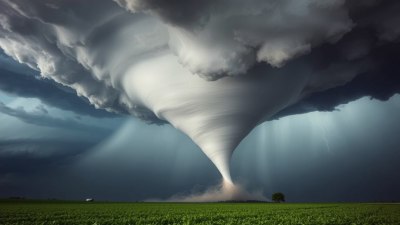What Causes Heavy Rain Without Lightning
Explore the phenomena behind heavy rain events that occur without lightning, understanding weather patterns and conditions.

This image was created with the assistance of Freepik
Heavy rain without lightning is an often-misunderstood weather phenomenon that can occur under various atmospheric conditions. The expectation for storms typically carries the assumption of accompanying thunder and lightning, but this is not always the case. By examining the factors that contribute to heavy rainfall without lightning, we can gain insights into how different weather systems operate.
Understanding Rain Formation
To comprehend why heavy rain can occur without lightning, we need to start with the basics of how rain forms. Rain is produced when moisture in the atmosphere condenses into droplets that grow large enough to overcome air resistance and fall to the ground. This condensation occurs in various weather scenarios, and depending on the specific conditions, can occur both with and without electrical activity.
Role of Humidity
Humidity plays a crucial role in the potential for heavy rain formation. When the air contains a significant amount of moisture, it creates the right conditions for rain. High humidity can lead to saturation of the atmosphere, where the air is so full of moisture that it cannot hold any more. As a result, any additional moisture must condense into rain. In the absence of thunderstorms, this process can still lead to substantial rainfall.
Non-Convective Rainfall
One key factor in heavy rain without lightning is the type of weather system involved. Non-convective rainfall refers to precipitation that occurs without the strong vertical currents typical of thunderstorms. This type of rain may develop from stratus clouds, which are low, flat clouds that produce steady periods of rain. These clouds lack the upward motion needed to generate lightning, yet they can still produce considerable amounts of rain over extended periods.
Frontal Systems
Frontal systems, especially warm fronts, can bring heavy rain without thunder and lightning. A warm front occurs when warmer, moist air advances over cooler air, causing the warm air to rise gradually. As the warm air rises, it cools and moisture condenses into rain. This process can create prolonged periods of steady rain, although lighting is not typically associated with this type of precipitation. Such rain can be heavy, especially when there is significant moisture presence ahead of the front.
Orographic Lifting
Orographic lifting is another phenomenon that can result in heavy rain without accompanying thunder. This occurs when moist air is forced to rise over a mountain range or elevated terrain. As the air ascends, it cools, leading to condensation and rainfall. This process often results in heavy precipitation on windward slopes, where the air is forced upwards. Any lightning activity is typically minimal, especially compared to convective storms.
Shallow Convection
Shallow convection is another term to describe weather patterns that lead to rain without thunderstorms. In this scenario, localized heating of the earth's surface can cause pockets of warm air to rise, leading to the formation of cumulus clouds that may produce rain. This process does not involve the strong upward currents associated with severe storms, and therefore, thunderstorms and lightning are absent.
Cold Rain Fall
Cold rain events can also occur without lightning. This occurs when rain falls from stratiform clouds, typically associated with overcast conditions. Related often to cooler temperatures, this type of rain can be persistent and may seem heavy, but because it lacks the energy associated with thunderstorms, lightning is infrequent. Knowledge about these cold rain events can be crucial for areas that rely on consistent precipitation for agriculture or water supply.
Weather Patterns and Climate Factors
Weather patterns, influenced by climate factors, play a significant role in rainfall conditions without lightning. The El Niño Southern Oscillation (ENSO) is known to affect global weather patterns, including precipitation amounts in specific regions. During particular phases of ENSO, regions might experience increased chances of heavy rainfall along with significant moisture availability, leading to rain without thunderstorms.
Localized Weather Effects
Local geography can also have a significant impact on the occurrence of heavy rain without lightning. Areas surrounded by bodies of water, such as lakes or oceans, can experience high humidity and localized showers that do not include thunder or lightning. Additionally, urban heat islands can influence local weather by causing rising air currents, leading to frequent rain showers that lack the characteristics of electrical storms.
Potential Impacts of Heavy Rain Without Lightning
While heavy rain without thunderstorms may not pose the same immediate dangers as storms accompanied by lightning, it can still have significant impacts on the environment and human activities. Heavy, extended rainfall can lead to concerns such as flooding, soil erosion, and decreased visibility. In agriculture, consistent rain may impact farming activities, crop health, and soil management practices.
Monitoring and Prediction
Advancements in meteorological technology and forecasting techniques have improved our understanding of rain patterns, including heavy rain events without lightning. Doppler radar and satellite imagery allow meteorologists to track humidity levels, cloud formations, and moisture movement more accurately, leading to better forecasting of rainfall events. As a result, those living in affected regions can receive timely warnings and make necessary preparations.
Understanding what causes heavy rain without lightning involves a deep dive into meteorological science, exploring how moisture, atmospheric conditions, and geographical factors interplay in weather systems. While not as dramatic as thunderstorms, heavy rainfall events without lightning can still significantly affect communities, ecosystems, and the economy. By continuing to monitor and study these patterns, we can enhance our understanding and preparedness for various weather scenarios.











